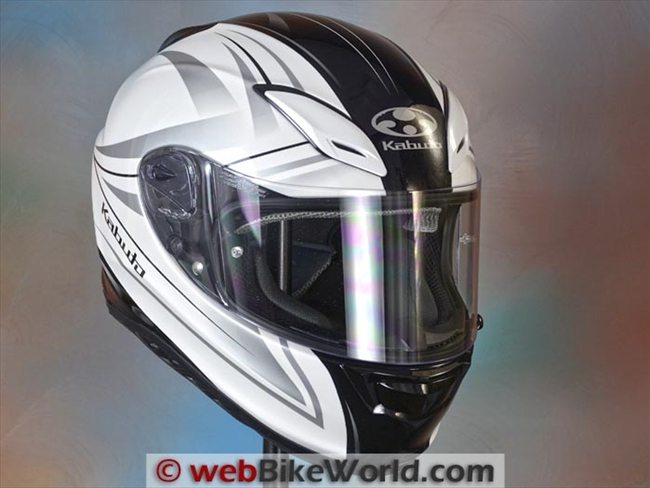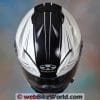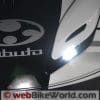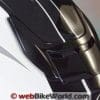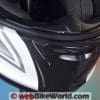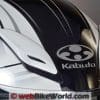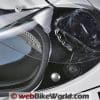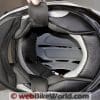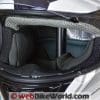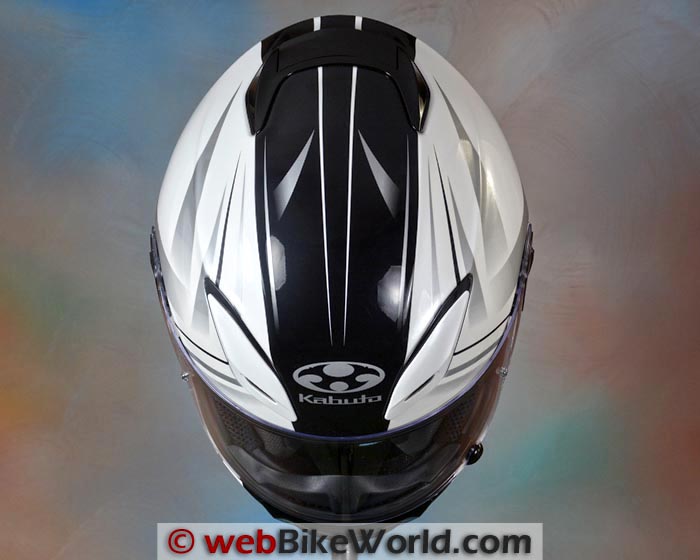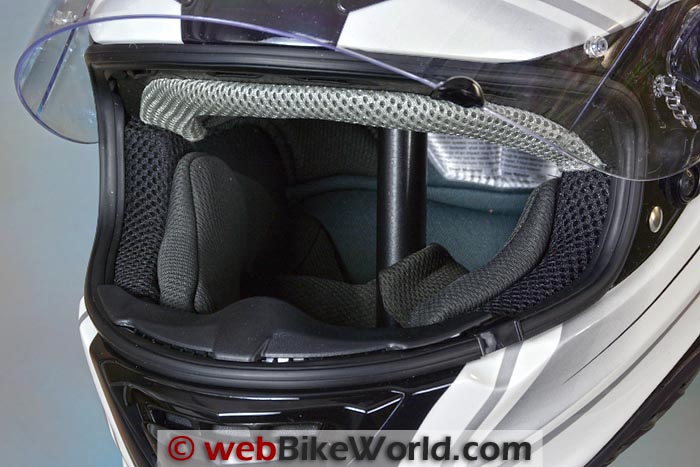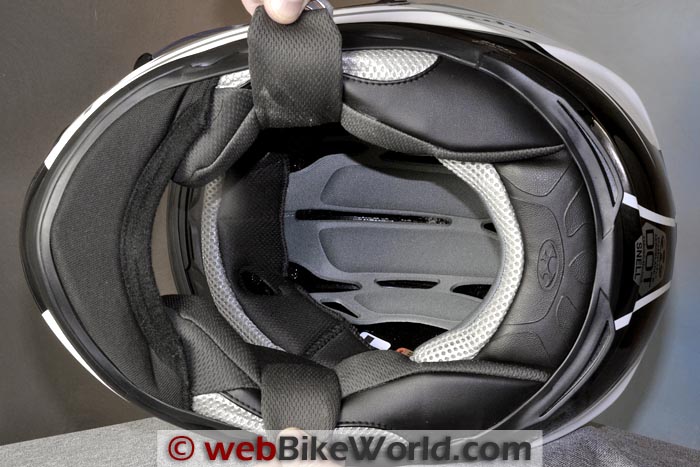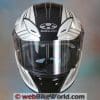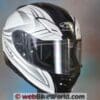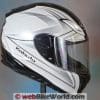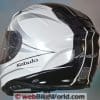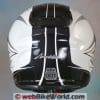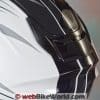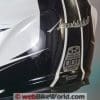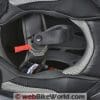The OGK Kabuto Aeroblade III is the newest version of the popular Aeroblade series.
It’s basically a street/sport version of the Kabuto FF-5V (review) that was reviewed recently on webBikeWorld.com.
The Aeroblade III uses the same type of composite shell and the internal shape and fit is roughly the same as the FF-5V.
There are some minor exterior differences between the helmets and the Aeroblade III is available in several color and graphics choices.
The helmet has outstanding ventilation, especially in the upper half of the helmet and the visibility from the wide and tall eye port is also better than average.
Like the FF-5V, the Aeroblade III meets the DOT standard in the U.S. and it’s also Snell M2010 certified.
Background
The Kabuto brand name is new to the U.S. market but OGK has been making helmets for over 35 years in Japan.
We reviewed the OGK FF-3 (review) on webBikeWorld in 2003; that helmet was sourced in the UK.
OGK was/is sort of an “underground” motorcycle helmet brand, but many motorcycle racers have discovered that the helmets offer many real-world advantages and are characterized by outstanding ventilation and aerodynamics at a lower price point than Arai or Shoei.
OGK helmets have been popular here at webBikeWorld, where you can also find reviews of the OGK FF-4 “Aeroblade” (review) that was also sourced from the UK and the OGK FF-5 (review), purchased in Japan.
The OGK FF-5 was named the webBikeWorld Motorcycle Helmet of the Year in 2008 and I liked it so much that I bought a second back then.
The brand is now known as OGK Kabuto, or by the Kabuto brand in the U.S.A., distributed through Western Power Sports.
Besides the Kabuto FF-5V (review) and this review of the Aeroblade III, WPS is also distributing the street-oriented Kabuto Kamui and the open-face Avand II.
Note that helmets are no longer sold under the OGK brand; the company is now known as OGK Kabuto, with the emphasis on the Kabuto brand.
The Kabuto Aeroblade III: Paint, Graphics and Overall Quality
The Aeroblade III is available in the solid colors of Flat Black, Pearl White, Aluminum Silver and something called “Flat Gun”, along with three different graphic patterns, including the white and black “Linea” graphics shown here.
The Linea graphics are very nice — not too gaudy but with enough style to hold one’s interest.
I could probably do without the “Kabuto” text on the sides of the helmet; I’ll chalk that up to self-consciousness by a probably overzealous marketing effort to establish a new brand name.
The design and its application is well executed however and the helmet has a nice clearcoat and excellent overall appearance with no obvious flaws that I can find.
The moving parts — such as the vent sliders and operation of the face shield — all have a solid feel and work nicely. Like the FF-5V, the Kabuto helmets aren’t quite up to, say, Shoei quality…although it’s hard to put a finger on exactly what those differences might be.
It’s a matter of very slight differences, such as the face shield rotation on the Kabuto helmets, which doesn’t have quite the same crisp feel as recent Shoei helmets.
We’re talking very minor differences here and the fact that the Kabuto helmets are roughly 30% cheaper than equivalent Shoei or Arai helmets pretty much makes any differences moot.
And that fact that both the FF-5V and the Aeroblade III have among the best ventilation and visibility of any motorcycle helmets we’ve reviewed in 14 years is definitely a reason to take notice.
I’ll bet more than a few street riders and motorcycle racers will jump ship from those other brands once they try one of the new Kabuto products.
Score: The Kabuto Aeroblade III gets an “Excellent” rating from us for paint and overall quality. See the Summary Table at the bottom of the page for a description of our rating system.
Kabuto Aeroblade III Fit, Sizing and Internal Shape
As we mentioned in the FF-5V review, Western Powersports (the U.S. distributor for Kabuto) told us about the differences between all of the Japanese and Rest of World Kabuto helmets and U.S. versions.
The U.S. helmets have a “western” head form with an “intermediate” shape, similar to what is sold in Europe and Australia. The Kabuto helmets sold in Japan and Asia have more of round internal shape.
The FF-5V we reviewed was a size XL but our Aeroblade III is a size L, so any difference in the internal shape is masked slightly by the smaller head size. With a 60.5 cm “Round” head that is widest at the temples, I’m an in-between size.
Kabuto lists the size L as a 59-60 and XL as 61-62. The FF-5V fit me rather nicely but the Aeroblade III in size L feels a bit tight just where I expected, above my ears at the temples.
But I’d say that the size L Aeroblade III fits as expected and like the FF-5V, I’ll call it a “Neutral” shape that should fit a range of head shapes from “Slightly Narrow” to “Slightly Round” according to the webBikeWorld Motorcycle Helmet Shapes page.
Kabuto also told us that the Aeroblade III shell, which comes in 3 sizes (XS/S, M/L, XL/XXL) to span the head size range, is slightly wider at the bottom for an easier on/off for street riders.
I agree that the helmet does slide on and off my head pretty smoothly, which for me can be unusual in a size large.
The internal shape of the Aeroblade III feels similar to my Arai RX-Q (review) in size XL, although the Arai has just a touch more forehead room.
The bottom line here is that the Kabuto FF-5V has a “generous” fit that should work for many head shapes, other than the very narrow.
The removable cheek pads and upper helmet liner are comfortable and the padding is generous in the Aeroblade III. It feels very similar to the FF-5V (no surprise there), right down to the slightly less firm stuffing, but that’s a matter of preference.
The Aeroblade III ear pockets are a touch shallow and narrow, with a sort of pocket that’s formed by part of the cheek pads, which cut across what would be the ear pocket.
Speakers can be installed but the gasket around the bottom of the helmet is styled on the sides with a shark-gill type of cutout arrangement, and this makes it a bit tricky to install a standard intercom mount.
It’s somewhat ironic that it’s easier to install an intercom in the race-oriented FF-5V than the street-oriented Aeroblade III. And by the way, I am able to fit my straight-temple eyeglasses in the Aeroblade III.

Overall, we rate the Kabuto Aeroblade III as very comfortable, especially for “Neutral” to “Slightly Narrow” head shapes
More information on helmet fit can be found in the webBikeWorld Motorcycle Helmet FAQ page.
Also, see the chart that lists the helmet weights of webBikeWorld reviewed helmets and also by shape on the webBikeWorld Motorcycle Helmet Shapes page.
Score: The Kabuto Aeroblade III gets an “Excellent” rating for comfort and liner materials and padding and a comfortable fit.
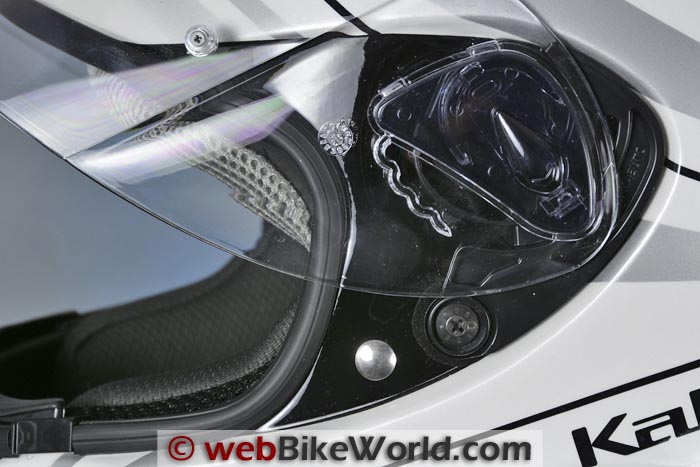
Kabuto Aeroblade III Face Shield, Eye Port and Visibility
Like the FF-5V, the Aeroblade III has excellent visibility in both the vertical and horizontal planes and both are similar to the Shoei RF-1200 (review) recently reviewed on webBikeWorld.
The Aeroblade III comes with Pinlock anti-fog insert (review) studs on the face shield and a Pinlock insert is included in the box.
The face shield is similar on both helmets and our Aeroblade III face shield measures 2.08 mm thick. It also has a snap lock on the lower left-hand side to keep it firmly in place.
Again like the FF-5V, the Aeroblade III face shield has only three detents, so there’s no small first opening position for city riding or defogging.
The face shield locks tightly in place when the snap is pushed and the full-surround eye port gasket also prevents any water from entering in our “leak down” test. And one more similarity: the top and rear vents close tightly enough to prevent water from entering when riding in the rain.
The face shield does not have a VESC-8 label (nor does the Shoei RF-1200 or GT Air) and it’s marked “Not warranted shatterproof” (most helmet face shields are not warranted as shatterproof).
The removal system appears to be identical to the FF-5V and they’re both very easy to use and illustrated in our video below. Raise the shield, push in the button and the face shield slides out of a “U” shaped channel. To replace it, simply snap it back in.
The optical quality of the face shield is very good and the Aeroblade III does not have an internal sun visor.

Score: The Kabuto Aeroblade III gets an “Excellent” rating for the overall quality and operation of the face shield.
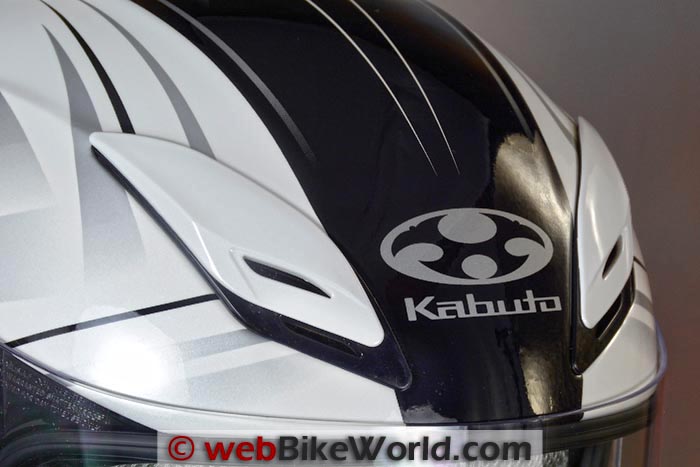
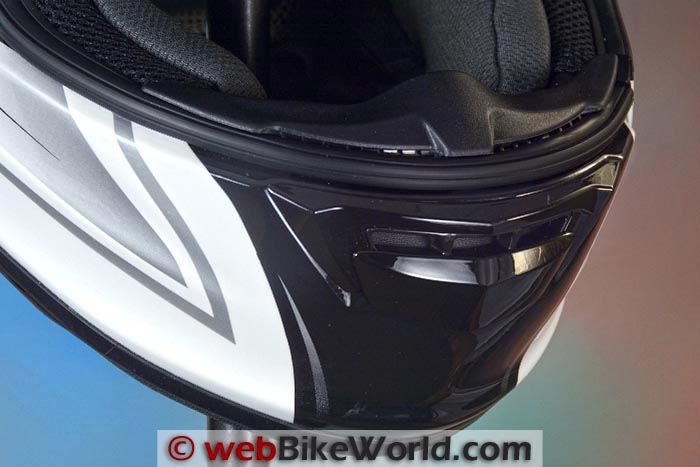
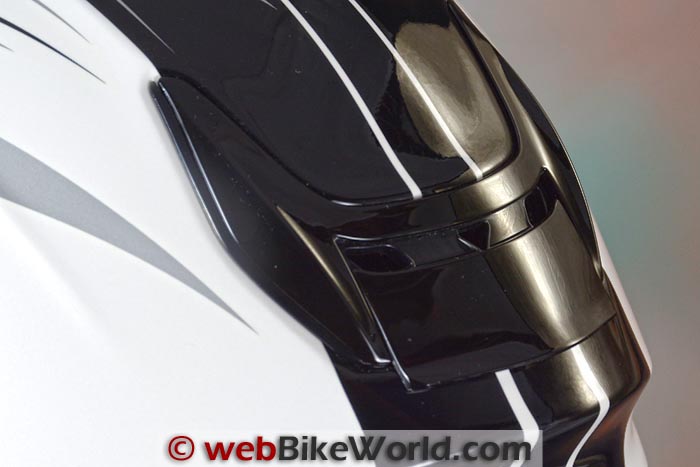
Ventilation and Air Flow
In another “thank you Kabuto” similarity, the Aeroblade III also has outstanding ventilation, also among the very best we’ve ever experienced.
Western Power Sports told us that they think the Aeroblade III even has more air flow than the FF-5V but I’m not sure. They’re both among the best of any full-face helmet I’ve ever worn.
I do know one thing: there’s so much air coming through the top vents that I have to close them in cooler weather or risk getting an ice-cream headache!
It’s not very often indeed when a full-face motorcycle helmet has that much air blowing through.
I also think the rear exhaust vent, which has direct openings down into the helmet that are clear enough that you can see right down inside, helps also.
The chin vent on the Aeroblade III doesn’t seem quite as effective to me though; it’s very good, no doubt about that, and it directs the air up on to the back of the face shield along the top of the chin bar, which helps defogging also.
But there are no direct channels for the air to flow through the chin bar and — despite the chin curtain — I get a lot of air flowing up into the helmet from underneath, even when I’m riding behind a windscreen.
The magic here is that the outstanding upper ventilation doesn’t cause any undue noise levels. Over the last year or so, the top three full-face helmets for ventilation are the Kabuto FF-5V (review), the Aeroblade III and the Shoei GT Air (review), which was named as the webBikeWorld 2013 Motorcycle Helmet of the Year.

Score: The Kabuto Aeroblade III ventilation system rates an “Outstanding” overall.
Kabuto Aeroblade III Noise Levels
With all that air flowing through the helmet, you might think the noise levels of the Aeroblade III would be a problem, but it isn’t so. In fact — and like the FF-5V — the helmet is actually pretty quiet.
OGK and now Kabuto has always had a reputation for excellent ventilation and aerodynamics and this remains true. The helmet seems to cut through the air and the sound levels are comparatively low. Considering the outstanding ventilation, that’s quite an achievement.
This is even mostly true when riding behind a windscreen.
I rode the BMW C 650 GT (blog) scooter several times wearing the Aeroblade III and I tilted the scooter’s electrically adjustable windscreen back and forth in all different positions, dumping air on the Aeroblade III and the helmet is always relatively quiet.

Note that our helmet evaluations are a combined effort of several riders over time on different types of motorcycles with and without windscreens.
Evaluators wear correctly fitted, high quality ear plugs (even when evaluating motorcycle intercom systems).
Always protect your hearing when riding a motorcycle. See the wBW Earplug Reviews for more information on choosing and wearing earplugs.
Note also that perceived noise levels will vary, depending on the individual.
Noise can be caused by many factors, including helmet fit, the type of motorcycle and windscreen, wind speed and direction and even the rider’s clothing.
For more information on helmet noise, visit the wBW Motorcycle Helmet Noise page.
Score: The Kabuto Aeroblade III gets an “Excellent” rating for noise control, which is amazing, considering the efficiency of the ventilation system.
Helmet Weight
But this is an excellent showing and it puts the Aeroblade III within the lightest 1/3 of the 220+ helmets we’ve reviewed so far on webBikeWorld.com.
Other helmets for comparison include the Arai Vector (review) in size XL at 1583 grams and theNexx XR1R (review) in size XL at 1588 grams.
Also the Akuma V-1 Ghost Rider (review) in size large at 1591 grams or the SCHUBERTH S2 (review)(ECE Version, size XL) at 1591 grams or the size L Arai RX-Q (review) at 1597 grams.
Note also that all of the helmets reviewed on webBikeWorld have been weighed and the weights are available on the wBW Motorcycle Helmet Weights page, along with a chart that lists the helmets by weight and shape on the wBW Motorcycle Helmet Shapes page.
Score: The Kabuto Aeroblade III gets an “Excellent” rating for its weight and good balance.
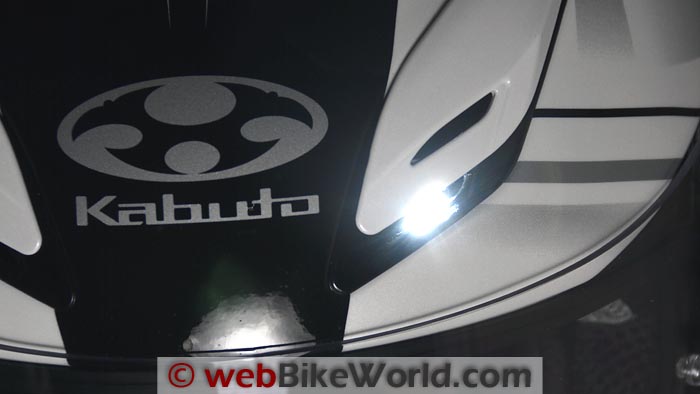


Miscellaneous
The Aeroblade III has a double D-ring chin strap retainer with comfortable and removable padding underneath.
Kabuto provides a five year warranty (from date of purchase) on their helmets and they have a discounted program for replacements if the helmet was in a crash.
- Outstanding ventilation.
- Relatively quiet.
- Nice styling.
- Comfortable liner.
- Water sealing.
- Too much ventilation?
- Needs firmer padding.
Conclusion
It’s hard to choose between the Kabuto Aeroblade III and the FF-5V; both have a lot of nice features and my feeling is that many motorcycle riders are going to be interested based on the outstanding ventilation that both of these helmets provide.
Both also have the DOT (natch) and the Snell M2010 certs, which is a plus.
The Aeroblade III can be found for around $314.95 for the solid colors and $359.95 for the graphics, making for a pretty good deal for this much helmet…especially if you can compare it to offerings from Arai and Shoei.
If you’re not familiar with the OGK/Kabuto brand, it may be time to do so. We’ve been reviewing these helmets for many years and have always been impressed.
Owner Comments and Feedback
See details on submitting comments.
From “A.A.” (May 2016): “I have followed your website for some time now and used it to extensively research gear and accessories. For this email though, I wanted to share some of my thoughts and experience with the Kabuto Aeroblade 3.
For reference, its a size large and looks like it was produced this year. I just ordered (and received) one in the mail late last week, Friday actually and arrived the very next day! How is that for fast shipping?
Couldn’t find much information on the website, since the US page is a little light on details, but I was happy to pull the liner out of the helmet and see the helmet has been updated to the Snell M2015 standard!
I checked the Snell website and confirmed the results, looks like the newest version of this helmet received the M2015 certification which is great.
I took the time to weigh the helmet on my postal scale and the results surprised me. The helmet itself (with a Sena SMH-10) is 3 pounds and 12 ounces. The visor with a Pinlock insert installed is 5.1 ounces. Combined, I get 4 pounds and 3.1 ounces.
So maybe 4 pounds even if you removed the SMH-10, speakers and wiring inside. Maybe an ounce or so less if you took out the Pinlock insert.
I should’ve weighed the helmet without the intercom installed, but again I’m doubtful that is more than 2-3 ounces for the wiring and speakers.
But it looks like the helmet is pretty close to four pounds even, surprising given the last model with the Snell 2010 was only 3 pounds 8 ounces for the large size, I’m guessing that has to do with the Snell 2015 certification.
To be truthful, I can’t ‘feel’ the weight as compared to other helmets I’ve worn and if anything, it feels very balanced in the hand and once you wear it, the weight largely disappears.
On paper it seems really heavy and the shipping scale makes it out to be a clunker, but I don’t find it to be any less comfortable than my RPS-10 which is almost a full pound lighter.
Just for consistency sake, I checked my Snell 2010 HJC RPS-10 helmet in size large and the measurements look pretty accurate when compared to your review. I get 3 pounds 1.5 ounces for just the helmet, 4.3 ounces for the visor and 3 pounds 5.7 ounces for the helmet with visor installed.
You guys called for about 3 pounds 5 and 3/4 ounces, which is pretty much spot on with my measurement.
So it looks for sure like the Snell 2015 of the Aeroblade 3 is pushing around or at 4 pounds, depending if you’re running Pinlock in the visor or any other accessories.
Doesn’t look like anything has changed from the Snell 2010 version, down to the silly ‘shark gill’ plastic along the bottom of the liner.
I will say though, the ventilation with the visor closed and vent sliders open is fantastic. Spot on with the assessment in the review, amazing upper ventilation, pretty good at the chin vent and there is a noticeable increase in the exhaust efficiency when the rear spoiler vent is opened.
Also, not sure if its because of the design of the liner or those ‘shark gills’ or what, but I can also feel a lot of airflow around the front of the cheeks and ears, whether or not the vents are open or closed.
This is pretty nice when its warm out, but the helmet is probably too cold for very early spring or late fall/winter weather, since you can’t completely turn off the ventilation.
Also, the chin vent seems to need about 20-25 MPH before you feel anything. At very slow speeds, I have to have the visor open one click or I don’t feel any airflow. Once you get moving though, it does feel like there is an air conditioner pointed at your face.
This is the first helmet in size large where I didn’t immediately feel the need to go down to a smaller size cheek pad. It has a great fit and very comfortable, but still very secure.
I put the helmet on and I can’t twist it around my head, so its comfortable, snug, but also secure enough to maintain its position on the head.
I actually feel like I could go down in size to a medium, where as just about every other helmet I’ve tried definitely was too small in medium and large was a good fit.
For reference, I’ve owned/used an HJC CL-15, Bell Vortex, Bell RS-1 and an HJC RPS-10.
Interestingly, the sticker inside the Aeroblade 3 still seems to be wrong. They call for 58-59 cm for a size large, which is definitely off. If anything, it feels closer to 59-60 cm and could even be a hair larger.
Will send an update as I get more information and take the thing riding throughout the season.”


